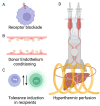Nanoparticle-Based Interventions for Liver Transplantation
- PMID: 37108659
- PMCID: PMC10144867
- DOI: 10.3390/ijms24087496
Nanoparticle-Based Interventions for Liver Transplantation
Abstract
Liver transplantation is the only treatment for hepatic insufficiency as a result of acute and chronic liver injuries/pathologies that fail to recover. Unfortunately, there remains an enormous and growing gap between organ supply and demand. Although recipients on the liver transplantation waitlist have significantly higher mortality, livers are often not allocated because they are (i) classified as extended criteria or marginal livers and (ii) subjected to longer cold preservation time (>6 h) with a direct correlation of poor outcomes with longer cold ischemia. Downregulating the recipient's innate immune response to successfully tolerate a graft having longer cold ischemia times or ischemia-reperfusion injury through induction of immune tolerance in the graft and the host would significantly improve organ utilization and post-transplant outcomes. Broadly, technologies proposed for development aim to extend the life of the transplanted liver through post-transplant or recipient conditioning. In this review, we focus on the potential benefits of nanotechnology to provide unique pre-transplant grafting and recipient conditioning of extended criteria donor livers using immune tolerance induction and hyperthermic pre-conditioning.
Keywords: hyperthermia; liver transplant; nanoparticles; tolerance.
Conflict of interest statement
R.I. is an inventor listed on several nanoparticle patents. All patents are assigned to either Johns Hopkins University or Aduro Biosciences, Inc. R.I. is a member of the Scientific Advisory Board of Imagion Biosystems. All other authors report no other conflicts of interest. The funders had no role in the writing of the manuscript; or in the decision to publish the results.
Figures

Similar articles
-
Livers from fasted rats acquire resistance to warm and cold ischemia injury.Transplantation. 1993 Apr;55(4):728-32. doi: 10.1097/00007890-199304000-00008. Transplantation. 1993. PMID: 8475543
-
The effect of a hydrogen sulfide releasing molecule (Na2S) on the cold storage of livers from cardiac dead donor rats. A study in an ex vivo model.Cryobiology. 2015 Aug;71(1):24-32. doi: 10.1016/j.cryobiol.2015.06.006. Epub 2015 Jun 16. Cryobiology. 2015. PMID: 26092670
-
Donor brain death reduces survival after transplantation in rat livers preserved for 20 hr.Transplantation. 2001 Nov 27;72(10):1632-6. doi: 10.1097/00007890-200111270-00009. Transplantation. 2001. PMID: 11726822
-
Research progress on hepatic machine perfusion.Int J Med Sci. 2021 Mar 3;18(9):1953-1959. doi: 10.7150/ijms.56139. eCollection 2021. Int J Med Sci. 2021. PMID: 33850464 Free PMC article. Review.
-
Expanding the donor pool: use of marginal donors for solid organ transplantation.Clin Transplant. 1996 Feb;10(1 Pt 1):1-19. Clin Transplant. 1996. PMID: 8652891 Review.
Cited by
-
Liver-Targeting Nanoplatforms for the Induction of Immune Tolerance.Nanomaterials (Basel). 2023 Dec 26;14(1):67. doi: 10.3390/nano14010067. Nanomaterials (Basel). 2023. PMID: 38202522 Free PMC article. Review.
References
Publication types
MeSH terms
Grants and funding
LinkOut - more resources
Full Text Sources
Medical
Miscellaneous

